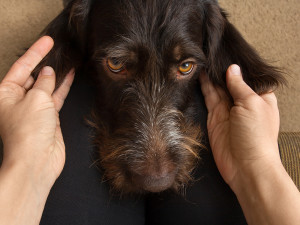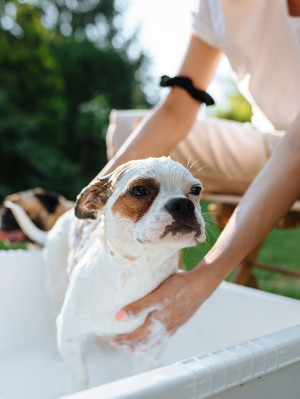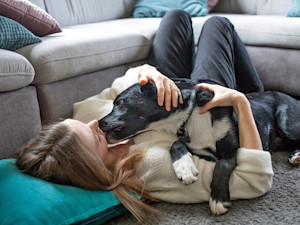Dog Yeast Infection Home Remedy: Natural Treatments
What’s that smell coming from your dog? We regret to inform you that it may be a yeast infection. Here’s what to do.
In This Article:
Understanding Dog Yeast Infections Veterinary Care for Yeast Infections When to Try a Home Remedy Home Remedies for Dog Yeast Infections
Each dog has their own unique odor that usually smells like a familiar, comforting friend. But sometimes that odor becomes a little more offensive, especially if your dog is also scratching constantly, shaking their head, or their skin becomes red and inflamed. This could mean your dog is dealing with a yeast infection, a common issue in certain dog breeds and one that may have you seeking out natural treatments rather than medications.
There are, indeed, some at-home options you can try for yeast infections in dogs. But be sure to get your dog a proper diagnosis from a veterinarian before turning to natural remedies for their skin or ears.
Snap a pic of your pup’s teeth, and GREENIES™ will help you spot potential signs of oral health issues.
How much do you spend on your pet per year?
Understanding dog yeast infections
Believe it or not, your dog’s skin is literally covered in things that we typically think of as bad: bacteria and fungi, being at the forefront. Some types of bacteria and fungi are actually an important part of a healthy skin environment and are there to help your dog, rather than harm them. However, sometimes that perfect harmony can get disrupted, allowing yeast populations to outgrow their strict confines, leading to a yeast infection of the skin or ears.
Causes of dog yeast infections
The cause of a yeast infection is an overgrowth of yeast, but there’s a bit more behind it than just that. In a normal, healthy dog, yeast numbers are kept in check by a healthy immune system. So, when a yeast infection occurs, it’s usually due to some disruption in the immune system. Factors such as allergies or illnesses can affect how the immune system normally responds, allowing yeast and other normal skin inhabitants to get out of hand.
You may see yeast infections pop up in a dog’s ears or on their skin during certain times of the year when pollens, dust, or mold are particularly high. Or your dog may have a problem year-round if they’re allergic and exposed to things like cigarette smoke or cleaning products. Even their own dog food can trigger their allergies.
A healthy immune system aside, yeast infections can be made worse by moisture. Yeast loves warm, wet places. That’s why yeast infections are most common in the ear canals or skin folds. If a dog is frequently bathed, swims, or plays in the rain and doesn’t get properly dried, they could experience a yeast infection.
Symptoms of yeast infections in dogs
Yeast infections are most commonly confined to dark, moist areas of the body, such as the ears, skin folds, paws, groin, or armpits. So the signs you see are often localized to these areas.
Here are some symptoms that indicate a yeast infection has started:
Itching, scratching, head shaking, pawing, rubbing, and otherwise utilizing you to help relieve the itch
Red skin and heat in the early stages, thickened grey or black skin if the condition persists
Greasy, scaly skin
Greasy discharge from the ear
A distinct odor that some describe as cheesy or musty
Common breeds affected by yeast infections
No dog is immune to yeast infections. Those little fungi are everywhere, and all it often takes is a momentary lapse in immune function to give them free rein.
Some breeds have more issues with yeast infections than others. For some, it’s because they have a lot of skin folds — or floppy ears — that love to harbor and nurture yeast. For others, it’s because of their propensity for developing allergies.
These are the dog breeds more affected by yeast infections:
Cocker Spaniel
Labrador Retriever
Golden Retriever
Basset Hound
Shih Tzu
German Shepherd
Veterinary care for yeast infections
A lot of issues can cause red, itchy skin, so it’s important to get a veterinary diagnosis for a yeast infection before starting any treatment. Your vet can do this by scraping a dog’s skin or taking a sample of the discharge from their ear, then looking for an abundance of yeast under a microscope. Skin biopsies or blood work may be necessary in some cases.
From there, your vet will prescribe medications that can be used on the skin, such as shampoosopens in new tab, cleaners, drops, or ointments. Chronic, difficult conditions may require oral medications. No matter the chosen treatment for your dog’s itchy skin, the course is a long one, often taking several months to get things back to normal.
When to try a home remedy for dog yeast infections
We all want to avoid medications if possible — veterinarians included — because they come with potential side effects, especially if given long-term. But that doesn’t mean you should jump right into an at-home skin treatment without knowing exactly what’s going on with your dog. Some natural treatments can be ineffective at the very least, but they could also cause more problems than they help solve.
After a diagnosis, speak to your vet about natural options, if they recommend them, and how to use them. Very few at-home yeast infection treatments have been scientifically studied, and they often work better as preventative measures rather than as treatments.
Home remedies for dog yeast infections
In this age of Google, you’re likely to run across these natural yeast-infection treatments, so let’s talk a bit about them. Keep in mind that these at-home options have not been thoroughly vetted and should be discussed with your vet to avoid causing further issues.
Apple cider vinegar
From lowering your blood sugar to weight loss, what can’t apple cider vinegar (allegedly) do? As far as yeast infections in dogs go, there may be some merit to the idea that a diluted vinegar rinse can help change the pH of your dog’s skin, thus making it less favorable for yeast growth. On the flip side, vinegar can also irritate the skin if not diluted properly, so be sure to check with your vet for guidance on usage.
Coconut oil
Just like apple cider vinegar, coconut oil is touted as having magical powers in healing and health. The idea behind this is due to coconut oil’s natural anti-fungal properties and ability to soothe irritated skin. Again, it can be irritating or ineffective, so speak to your vet first.
Yogurt and probiotics
When you have an abnormal amount of something growing anywhere in your dog’s body, one defense is to counterbalance it. This is the reason behind using yogurt and probiotics for yeast infections. Feeding yogurt or probiotic supplements can boost gut and immune health, helping your dog fight the infection. Yogurt isn’t used as a sole treatment but rather as an add-on to other methods advised by your vet.
Herbal rinses
Along with vinegar, you may come across skin rinses containing chamomile, colloidal silver, or lemon juice, which are purported to decrease yeast numbers and heal skin. These can be dicey and irritating, so don’t use them unless advised by your vet.
Avoid allergens
If allergies are at the root of your dog’s yeast infection, it goes without saying that avoiding them should help. This is where you brush your hands together and say “done,” right? If only it were that simple. Avoiding allergens can involve anything from a diet change for dogs with food allergies to removing certain plants from your yard to minimize environmental allergies. Other allergens aren’t as easy to avoid, so you may need to talk to your vet about allergy treatment for your dog.
Dietary changes
No, there isn’t a yeast infection diet, so to speak. But if your dog is allergic to food, it’s probably because of the protein they’re eating. Chicken, beef, and eggs are common culprits, so switching to a novel protein diet that doesn’t contain the offender can really help.
Beta-glucans
Beta-glucans are a type of fiber that provides nourishment to the probiotics in your dog’s gut. They can help boost immune functionopens in new tab, which could help in controlling yeast infections.
Dry it up
Because yeast needs moisture to reproduce, keeping your dog dry can go a long way. Thoroughly dry your pup’s coat after they take a bath, swim, or play in the rain. Pay extra attention to the groin, armpits, ears, feet, and skin folds.
Bottom line
Yeast normally cohabitates on your dog’s skin. When their presence gets out of hand, it can create itchy, red, scaly, greasy skin or ears that often has a distinct odor. If your dog has any of these signs, see your vet for a proper diagnosis. Although you may come across numerous at-home or natural yeast-infection treatments, it’s important to follow the advice of your veterinarian.
References
Brooks, Wendy, DVM DABVP. “Food Allergies in Dogs and Cats.” Veterinary Partner. 26 Aug 2023. veterinarypartner.vin.com/default.aspx?pid=19239&id=4951526opens in new tab.
Cohen, Aly DVM. “How to Clean Your Dog’s Ears.” Cornell Richard P. Riney Canine Health Center. vet.cornell.edu/departments-centers-and-institutes/riney-canine-health-center/canine-health-information/how-clean-your-dogs-earsopens in new tab.
Gunnars, Kris. “6 Health Benefits of Apple Cider Vinegar, Backed by Science.” Healthline. 1 Apr 2024. healthline.com/nutrition/6-proven-health-benefits-of-apple-cider-vinegaropens in new tab.
Williams, Krista BSc, DVM, CCRP; Tammy Hunter, DVM; and Ernest Ward, DVM. “Yeast Dermatitis in Dogs.” VCA Animal Hospitals. vcahospitals.com/know-your-pet/yeast-dermatitis-in-dogsopens in new tab.











